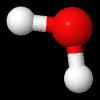Electromagnetic absorption by water
(Redirected from Water absorption)
Electromagnetic Absorption by Water
Electromagnetic absorption by water refers to the process by which water molecules absorb electromagnetic (EM) energy across various frequencies of the electromagnetic spectrum. This phenomenon is crucial in numerous scientific and industrial applications, including microwave heating, atmospheric science, and telecommunications.
Overview[edit | edit source]
Water is a polar molecule, meaning it has a partial positive charge on one side and a partial negative charge on the other. This polarity makes water highly responsive to electromagnetic fields, leading to the absorption of energy at specific frequencies. The most significant absorption occurs in the microwave region, which is utilized in microwave ovens to heat food, but absorption also occurs at infrared, visible, ultraviolet, and even radio frequencies to varying degrees.
Mechanisms of Absorption[edit | edit source]
The primary mechanism for electromagnetic absorption in water is the rotation of water molecules. In an electromagnetic field, the polar water molecules attempt to align themselves with the field, leading to rotation and, consequently, the conversion of electromagnetic energy into thermal energy. Additionally, at higher frequencies, such as in the ultraviolet range, electronic transitions and vibrational modes can also contribute to absorption.
Applications[edit | edit source]
Microwave Heating: Utilizes the strong absorption of microwaves by water to heat food and other substances. Atmospheric Science: Understanding water's absorption characteristics is essential for weather radar and satellite observations, as water vapor significantly influences atmospheric electromagnetic propagation. Telecommunications: The presence of water vapor can affect the transmission of radio waves, particularly at higher frequencies used in satellite communications.
Environmental and Biological Effects[edit | edit source]
The absorption of electromagnetic energy by water is not only a physical phenomenon but also has environmental and biological implications. For instance, the heating of water bodies by solar radiation affects climate patterns and ecosystems. In biological tissues, which are largely composed of water, the absorption of electromagnetic radiation is a basis for techniques such as MRI but also raises concerns about exposure to high levels of non-ionizing radiation.
Research and Development[edit | edit source]
Ongoing research in the field of electromagnetic absorption by water aims to better understand the molecular dynamics involved and to exploit this knowledge in developing more efficient technologies for energy transfer, sensing, and communication.
This article is a environment-related stub. You can help WikiMD by expanding it!
Electromagnetic absorption by water
Electromagnetic absorption by water
Electromagnetic absorption by water
Electromagnetic absorption by water
Search WikiMD
Ad.Tired of being Overweight? Try W8MD's physician weight loss program.
Semaglutide (Ozempic / Wegovy and Tirzepatide (Mounjaro / Zepbound) available.
Advertise on WikiMD
|
WikiMD's Wellness Encyclopedia |
| Let Food Be Thy Medicine Medicine Thy Food - Hippocrates |
Translate this page: - East Asian
中文,
日本,
한국어,
South Asian
हिन्दी,
தமிழ்,
తెలుగు,
Urdu,
ಕನ್ನಡ,
Southeast Asian
Indonesian,
Vietnamese,
Thai,
မြန်မာဘာသာ,
বাংলা
European
español,
Deutsch,
français,
Greek,
português do Brasil,
polski,
română,
русский,
Nederlands,
norsk,
svenska,
suomi,
Italian
Middle Eastern & African
عربى,
Turkish,
Persian,
Hebrew,
Afrikaans,
isiZulu,
Kiswahili,
Other
Bulgarian,
Hungarian,
Czech,
Swedish,
മലയാളം,
मराठी,
ਪੰਜਾਬੀ,
ગુજરાતી,
Portuguese,
Ukrainian
Medical Disclaimer: WikiMD is not a substitute for professional medical advice. The information on WikiMD is provided as an information resource only, may be incorrect, outdated or misleading, and is not to be used or relied on for any diagnostic or treatment purposes. Please consult your health care provider before making any healthcare decisions or for guidance about a specific medical condition. WikiMD expressly disclaims responsibility, and shall have no liability, for any damages, loss, injury, or liability whatsoever suffered as a result of your reliance on the information contained in this site. By visiting this site you agree to the foregoing terms and conditions, which may from time to time be changed or supplemented by WikiMD. If you do not agree to the foregoing terms and conditions, you should not enter or use this site. See full disclaimer.
Credits:Most images are courtesy of Wikimedia commons, and templates, categories Wikipedia, licensed under CC BY SA or similar.
Contributors: Prab R. Tumpati, MD







